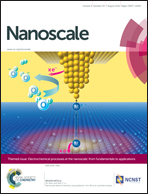Interfacial strain and defects in asymmetric Fe–Mn oxide hybrid nanoparticles†
Abstract
Asymmetric Fe–Mn oxide hybrid nanoparticles have been obtained by a seed-mediated thermal decomposition-based synthesis route. The use of benzyl ether as the solvent was found to promote the orientational growth of Mn1−xO onto the iron oxide nanocube seeds yielding mainly dimers and trimers whereas 1-octadecene yields large nanoparticles. HRTEM imaging and HAADF-STEM tomography performed on dimers show that the growth of Mn1−xO occurs preferentially along the edges of iron oxide nanocubes where both oxides share a common crystallographic orientation. Fourier filtering and geometric phase analysis of dimers reveal a lattice mismatch of 5% and a large interfacial strain together with a significant concentration of defects. The saturation magnetization is lower and the coercivity is higher for the Fe–Mn oxide hybrid nanoparticles compared to the iron oxide nanocube seeds.



 Please wait while we load your content...
Please wait while we load your content...